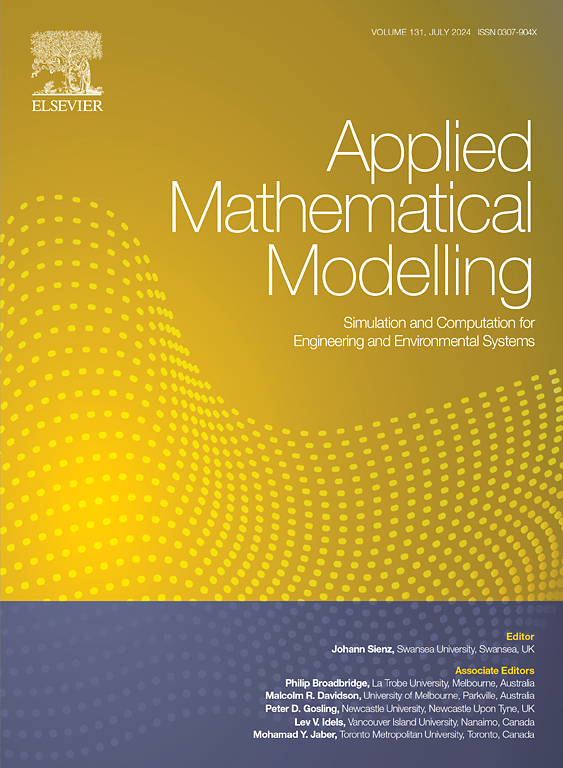Trampoline metamaterial coupled with Helmholtz resonator for enhanced acoustic piezoelectric energy harvesting
IF 4.4
2区 工程技术
Q1 ENGINEERING, MULTIDISCIPLINARY
引用次数: 0
Abstract
To enhance acoustic piezoelectric energy harvesting at lower frequencies, this study proposes a coupled structure comprising a trampoline metamaterial and a Helmholtz resonator. The trampoline metamaterial incorporates periodically arranged composite resonant pillars embedded in a perforated thin plate. By designing a point defect in the metamaterial, vibro-acoustic energy can be intentionally confined to the defect location at the defect band frequency. Considering the amplified acoustic pressure in the Helmholtz resonator, the incorporation of the trampoline metamaterial into a Helmholtz resonant cavity enables enhanced energy localization. Initially, a mathematical model for calculating the first resonant band gap is established. The band gap and corresponding defect band frequency are then validated by comparing numerical simulation with experimental results. Subsequently, numerical simulations are conducted to investigate the influences of hole radius and coupled structure on piezoelectric energy harvesting performance. These simulations revealed that an increase in the hole radius significantly enhances vibro-acoustic localization and piezoelectric conversion efficiency of the trampoline metamaterial. Furthermore, the synergistic interaction of the coupled structure between the defect state in the trampoline metamaterial and the acoustic pressure amplification in the Helmholtz resonator further enhances the energy harvesting performance. At an acoustic incident amplitude of 2 Pa and a defect band frequency of 1068.5 Hz, the coupled structure attains a maximum output voltage of 5.94 V and power of 39.10 μW. These values demonstrate enhancements of 2.65 times and 2.80 times, respectively, compared to the uncoupled trampoline metamaterial with a hole radius of r0=1.5 mm. Such findings offer guidance for designing piezoelectric energy harvester in applications such as self-powered sensors and small electrical devices.
结合亥姆霍兹谐振腔的蹦床超材料增强声压电能量收集
为了增强低频声压电能量收集,本研究提出了一种由蹦床超材料和亥姆霍兹谐振器组成的耦合结构。所述蹦床超材料包含嵌入穿孔薄板中的周期性排列的复合谐振柱。通过在超材料中设计点缺陷,可以有意地将振动声能量限制在缺陷频带频率处的缺陷位置。考虑到亥姆霍兹谐振腔内的声压放大,将蹦床超材料掺入亥姆霍兹谐振腔可以增强能量局域化。首先,建立了计算第一共振带隙的数学模型。通过数值模拟与实验结果的对比,验证了带隙和缺陷带频率的正确性。随后,通过数值模拟研究了孔半径和耦合结构对压电能量收集性能的影响。模拟结果表明,孔半径的增加显著提高了蹦床超材料的振动声定位和压电转换效率。此外,蹦床超材料中的缺陷态与亥姆霍兹谐振腔中的声压放大之间的耦合结构的协同作用进一步提高了能量收集性能。当声入射幅值为2 Pa,缺陷带频率为1068.5 Hz时,耦合结构的最大输出电压为5.94 V,功率为39.10 μW。与孔半径为0=1.5 mm的不耦合蹦床超材料相比,这些数值分别提高了2.65倍和2.80倍。这一发现为自供电传感器和小型电子设备等领域的压电能量采集器的设计提供了指导。
本文章由计算机程序翻译,如有差异,请以英文原文为准。
求助全文
约1分钟内获得全文
求助全文
来源期刊

Applied Mathematical Modelling
数学-工程:综合
CiteScore
9.80
自引率
8.00%
发文量
508
审稿时长
43 days
期刊介绍:
Applied Mathematical Modelling focuses on research related to the mathematical modelling of engineering and environmental processes, manufacturing, and industrial systems. A significant emerging area of research activity involves multiphysics processes, and contributions in this area are particularly encouraged.
This influential publication covers a wide spectrum of subjects including heat transfer, fluid mechanics, CFD, and transport phenomena; solid mechanics and mechanics of metals; electromagnets and MHD; reliability modelling and system optimization; finite volume, finite element, and boundary element procedures; modelling of inventory, industrial, manufacturing and logistics systems for viable decision making; civil engineering systems and structures; mineral and energy resources; relevant software engineering issues associated with CAD and CAE; and materials and metallurgical engineering.
Applied Mathematical Modelling is primarily interested in papers developing increased insights into real-world problems through novel mathematical modelling, novel applications or a combination of these. Papers employing existing numerical techniques must demonstrate sufficient novelty in the solution of practical problems. Papers on fuzzy logic in decision-making or purely financial mathematics are normally not considered. Research on fractional differential equations, bifurcation, and numerical methods needs to include practical examples. Population dynamics must solve realistic scenarios. Papers in the area of logistics and business modelling should demonstrate meaningful managerial insight. Submissions with no real-world application will not be considered.
 求助内容:
求助内容: 应助结果提醒方式:
应助结果提醒方式:


